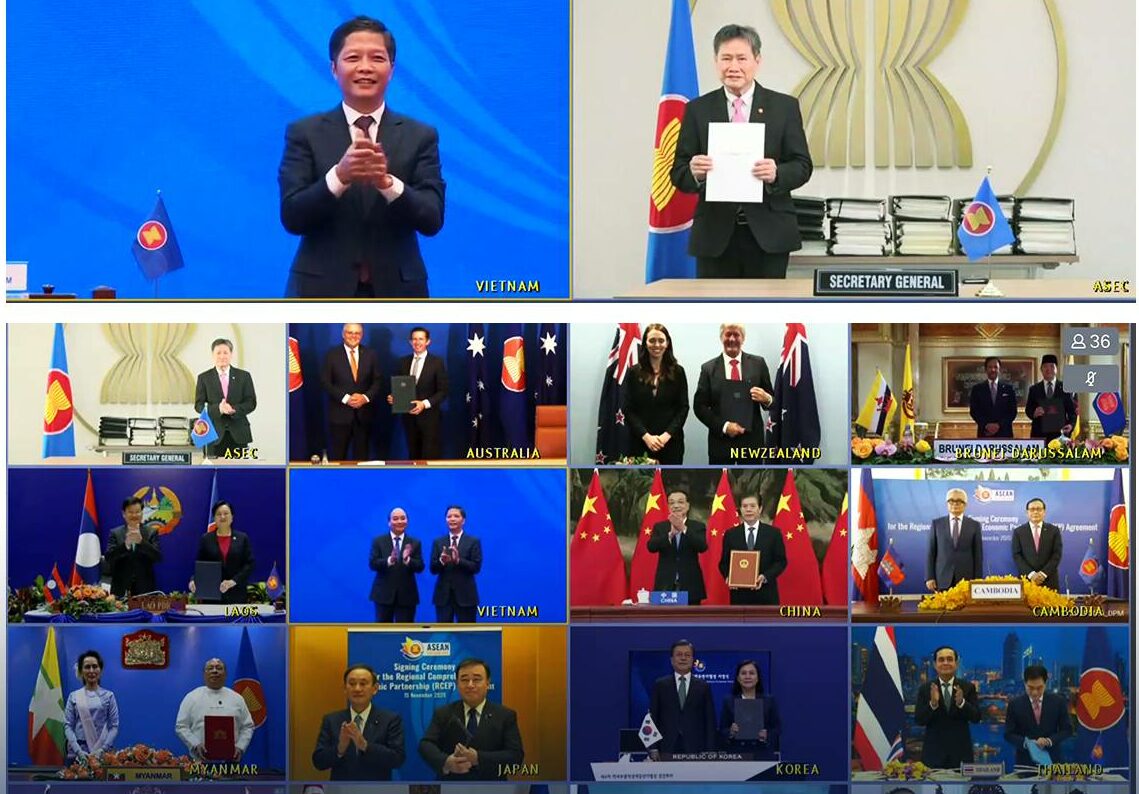Because Australia has snubbed the US and signed an agreement with China

Geopolitical objectives and implications of the agreement between 15 countries called the Regional Comprehensive Economic Partnership (RCEP) including China, Japan, South Korea, Singapore, New Zealand and Australia. Giuseppe Gagliano's analysis
The agreement signed on November 15 called the Regional Comprehensive Economic Partnership (RCEP) between 15 regional economies including China, Japan, South Korea, Indonesia, Cambodia, Vietnam, Thailand, Philippines, Singapore, Brunei, Burma, Laos, Cambodia and Vietnam, New Zealand and Australia will involve 2.2 billion consumers, that is almost a third of the world population.
This historic partnership was signed in Hanoi, Vietnam, on the sidelines of an ASEAN meeting aimed at finding a solution to disputes over the South China Sea.
Under this agreement, the contracting countries will lower customs tariffs allowing export products to circulate within them without having to comply with specific procedures for each individual country.
This synergy is likely to eliminate 90% of the export tariffs between the parties within the next 20 years and will involve many sectors of commerce such as e-commerce, competition policies and intellectual property rights. So far the facts.
There is no doubt that this agreement will allow the Dragon to present itself as a true champion of globalization and multilateral cooperation by giving China greater influence on the rules that govern regional trade.
Secondly, it is difficult to deny that this agreement – strongly backed by China – is aimed at limiting and containing the American agreement known as the Trans-Pacific Partnership (TPP).
Thirdly, this agreement is broad enough to easily allow different countries to adapt without having the strict constraints placed by the European Union on its members.
Fourthly, the agreement will only strengthen Chinese power projection in relation to the New Silk Road, certainly contributing to downsizing American hegemony in Asia despite the political choices of the magnificent Trump-Pompeo duo to limit Chinese hegemonic ambitions. .
Fifth, some of those who have signed up to this agreement – such as Australia and New Zealand for example – demonstrate how these countries are not willing to give up the huge gains that such an agreement will bring despite their political loyalty. and military to the USA. Nothing surprising from a historical point of view: Venice, despite being a Catholic country, never gave up on continuing its commercial relations with the Ottoman Empire despite the Crusades. We could say with a joke: pecunia non olet. Yesterday like today.
Sixthly, the fact that India has not acceded to this agreement is also determined – but not only – by the fact that India intends, through the agreement with the United States, to limit Chinese hegemony in the Indo Pacific . Well, precisely in this regard, one of the questions we must ask ourselves, especially in the light of the numerous articles we have had the opportunity to write in relation to the conflictual relationship between Australia and China, is why this nation has joined this agreement. We could answer with a joke: Australia is not the center of the Asian solar system but is only one of its moons. But what does it all mean?
First, we must not forget that the Chinese invest more than $ 10 billion a year in Australia in both real estate, infrastructure, healthcare, mining and agribusiness. Well, if a decline in Chinese investments in the country or simply a reduction were to occur, this would represent a real collapse for the Australian economy. This agreement avoids an eventuality of this nature.
Secondly, Australia has increasingly close economic and military ties with Japan, India and Vietnam. Indeed, we must not forget that ASEAN is Australia's second largest trading partner after China.
Thirdly, Australia has long been reinvesting its mining proceeds in new mining technologies that are being sold to the Chinese in the new Sino Australian industrial park on Zhoushan Island.
Fourth, another source of significant Chinese investment in Australia is from tourists. In fact, about 9 million Asian tourists come to Australia and nearly 100,000 Chinese students enrolled in Australian schools. In this regard, we must not forget that Asians have now overtaken Europeans with their presence in Australia as they have become the largest ethnic group of migrants. It is enough to mention just one fact: 5% of the Australian population is of Chinese origin and overall 15% of the Australian population is of Asian ethnicity.
Now, beyond the specific case of Australia, this agreement will certainly lead to an acceleration of the integration process of the acceding countries. What does this mean in practice? It means, for example, that this agreement will only further incite the poorest members of Asia like Laos and Cambodia to China. It means that this agreement will increasingly bind Malaysia and the Philippines to China despite disputes over the South China Sea.
But it also means that despite the numerous conflicts between Vietnam and China on which the United States played to contain the projection of Chinese power, this agreement in our opinion could on the one hand allow the normalization of relations with China by weakening the hegemony of the The United States in Southeast Asia and on the other hand could make the freedom of navigation operations carried out by the United States, France and Great Britain in the South China Sea completely marginal.
This is a machine translation from Italian language of a post published on Start Magazine at the URL https://www.startmag.it/mondo/perche-laustralia-ha-snobbato-gli-usa-e-firmato-laccordo-con-la-cina/ on Wed, 18 Nov 2020 08:00:07 +0000.
